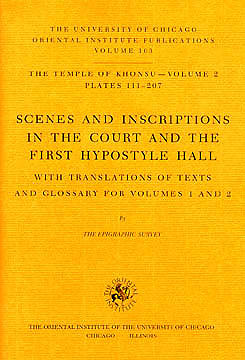OIP 103. The Temple of Khonsu, Volume 2: Scenes and Inscriptions in the Court and the First Hypostyle Hall The Epigraphic Survey

Purchase Download Terms of Use
With commendable promptitude, only two years after Volume 1 (cf. BiOr 38 [1981], 301–02), this volume comes to complete the record of the forecourt and main hypostyle hall of the temple of Khons in Karnak, by the Chicago Epigraphic Survey. We now at last possess a full and accurate record of the works of Ramesses XI and Herihor there, plus a whole series of supplementary scenes and texts from the Twenty-first Dynasty (Pinudjem I; Menkheperre), a text of Osorkon I, dedications by Nectanebo II, and texts and scenes of Ptolemy II, IV and IX, besides Alexander. Much of what appears here was earlier unpublished; what was known now appears in greatly enhanced form. Thus for Ramesses XI, we now have the full repertoire of scenes from his hypostyle hall which can now be compared with the content of other such halls (e.g., barque-scenes, litany of Victorious Thebes, occurring in the Great Hypostyle Hall of Amun's temple). On a different plane, we at last have a reliable edition of the important (if wretched looking) oracle stela of Herihor under Ramesses XI. In this, the high priest has some of his enquiries refused by the god, but he has 20 years granted him by Amun, plus the carving of a stela - perhaps this very one. The architrave-texts of Herihor as king are remarkably fulsome, and sometimes piquant, not to say amusing. His forecourt has silver, gold, precious gems 'by the bagful'; and Herihor is called 'valiant fighter in the midst of his enemy, who has conquered myriads.' Unless as army-leader he had crushed Libyan intruders, his sole real boast of military action is likely to have been the quelling of civil strife in Egypt itself, or action against the dissident viceroy Panehsy-a far cry from the glories usually implicit in Ramesside-type rhetoric!... The folio of plates is accompanied by a quarto booklet giving not only the list of plates and annotated translation of all texts, but also an informative preface by Dr. Kent Weeks, e.g., on the vicissitudes of royal and priestly features in the reliefs of Pinudjem I; he also indicates that this present volume (fruit of so many collaborators across the decades) was substantially the work of Dr. W. J. Murnane. A new and very welcome feature of the text-fascicle is its full glossary (in transliteration) of all texts in Vols. 1 and 2 of Khonsu. This glossary is admirably articulated, on a plan dear to this reviewer's heart: words are given not just with references, but also according to the phrases and constructions in which they are employed - a model of its kind... [From a review by K. A. Kitchen in Bibliotheca Orientalis 41 (1984) 84–85].
- Oriental Institute Publications 103
- Chicago: The Oriental Institute, 1981
- ISBN 978-0-91-898628-3
- Large portolio 14.5 x 18.5 in / 37 x 47 cm
- Pp. xxiii + 93 in booklet; 97 plates + key plans
- $115.00

